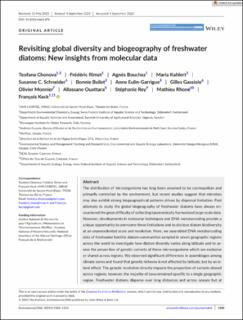| dc.contributor.author | Chonova, Teofana | |
| dc.contributor.author | Rimet, Frédéric | |
| dc.contributor.author | Bouchez, Agnès | |
| dc.contributor.author | Kahlert, Maria | |
| dc.contributor.author | Schneider, Susanne Claudia | |
| dc.contributor.author | Bailet, Bonnie | |
| dc.contributor.author | Eulin-Garrigue, Anne | |
| dc.contributor.author | Gassiole, Gilles | |
| dc.contributor.author | Monnier, Olivier | |
| dc.contributor.author | Ouattara, Allassane | |
| dc.contributor.author | Rey, Stéphanie | |
| dc.contributor.author | Rhoné, Mathieu | |
| dc.contributor.author | Keck, François | |
| dc.date.accessioned | 2024-04-19T11:17:48Z | |
| dc.date.available | 2024-04-19T11:17:48Z | |
| dc.date.created | 2023-10-22T14:55:37Z | |
| dc.date.issued | 2023 | |
| dc.identifier.citation | Environmental DNA. 2023, 5 (6), 1505-1515. | en_US |
| dc.identifier.issn | 2637-4943 | |
| dc.identifier.uri | https://hdl.handle.net/11250/3127422 | |
| dc.description.abstract | The distribution of microorganisms has long been assumed to be cosmopolitan and primarily controlled by the environment, but recent studies suggest that microbes may also exhibit strong biogeographical patterns driven by dispersal limitation. Past attempts to study the global biogeography of freshwater diatoms have always encountered the great difficulty of collecting taxonomically harmonized large-scale data. However, developments in molecular techniques and DNA metabarcoding provide a unique opportunity to overcome these limitations and to disclose diatom biodiversity at an unprecedented scale and resolution. Here, we assembled DNA metabarcoding data of freshwater benthic diatom communities sampled in seven geographic regions across the world to investigate how diatom diversity varies along latitude and to assess the proportion of genetic variants of these microorganisms which are exclusive or shared across regions. We observed significant differences in assemblages among climate zones and found that genetic richness is not affected by latitude, but by an island effect. The genetic resolution directly impacts the proportion of variants shared across regions; however, the majority of taxa remained specific to a single geographic region. Freshwater diatoms disperse over long distances and across oceans but at rates that allow the appearance of local genetic variants and the regionalization of assemblages. Future work should focus on putting these diversity dynamics into a temporal context, an approach that should be possible by bringing together new sequencing techniques and phylogeography. | en_US |
| dc.language.iso | eng | en_US |
| dc.rights | Navngivelse 4.0 Internasjonal | * |
| dc.rights.uri | http://creativecommons.org/licenses/by/4.0/deed.no | * |
| dc.title | Revisiting global diversity and biogeography of freshwater diatoms: New insights from molecular data | en_US |
| dc.type | Peer reviewed | en_US |
| dc.type | Journal article | en_US |
| dc.description.version | publishedVersion | en_US |
| dc.rights.holder | © 2023 The Authors | en_US |
| dc.source.pagenumber | 1505-1515 | en_US |
| dc.source.volume | 5 | en_US |
| dc.source.journal | Environmental DNA | en_US |
| dc.source.issue | 6 | en_US |
| dc.identifier.doi | 10.1002/edn3.475 | |
| dc.identifier.cristin | 2187376 | |
| cristin.ispublished | true | |
| cristin.fulltext | original | |
| cristin.qualitycode | 1 | |

